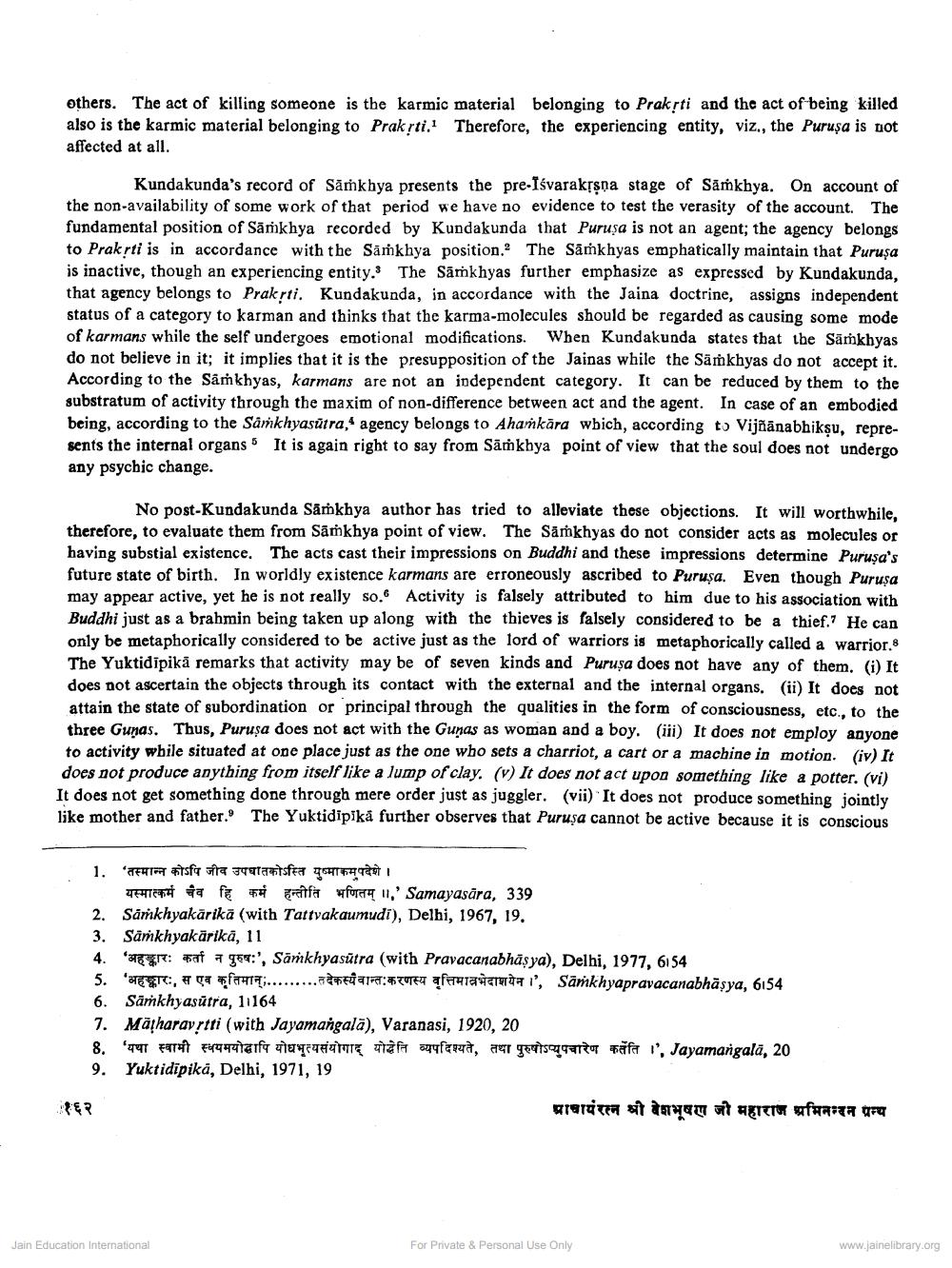Book Title: Kundakunda on Samkhyapurusa Author(s): Shivkumar Publisher: Z_Deshbhushanji_Maharaj_Abhinandan_Granth_012045.pdf View full book textPage 2
________________ others. The act of killing someone is the karmic material belonging to Prakrti and the act of being killed also is the karmic material belonging to Prakrti. Therefore, the experiencing entity, viz., the Puruşa is tot affected at all. Kundakunda's record of Sāṁkhya presents the pre-Isvarakļşna stage of Samkhya. On account of the non-availability of some work of that period we have no evidence to test the verasity of the account. The fundamental position of Sārkhya recorded by Kundakunda that Puruşa is not an agent; the agency belongs to Prakrti is in accordance with the Samkhya position. The Samkhyas emphatically maintain that Puruşa is inactive, though an experiencing entity. The Sámkhyas further emphasize as expressed by Kundakunda, that agency belongs to Prakrti. Kundakunda, in accordance with the Jaina doctrine, assigns independent status of a category to karman and thinks that the karma-molecules should be regarded as causing some mode of karmans while the self undergoes emotional modifications. When Kundakunda states that the Sāṁkhyas do not believe in it; it implies that it is the presupposition of the Jainas while the Samkhyas do not accept it. According to the Samkhyas, karmans are not an independent category. It can be reduced by them to the substratum of activity through the maxim of non-difference between act and the agent. In case of an embodied being, according to the Sankhyasútra, agency belongs to Ahankāra wbich, according to Vijñānabhiksu, represents the internal organs It is again right to say from Sarkhya point of view that the soul does not undergo any psychic change. No post-Kundakunda Samkhya author has tried to alleviate these objections. It will worthwhile, therefore, to evaluate them from Samkhya point of view. The Samkhyas do not consider acts as molecules or having substial existence. The acts cast their impressions on Buddhi and these impressions determine Purusa's future state of birth. In worldly existence karmans are erroneously ascribed to Puruşa. Even though Puruşa may appear active, yet he is not really so. Activity is falsely attributed to him due to his association with Buddhi just as a brahmin being taken up along with the thieves is falsely considered to be a thief. He can only be metaphorically considered to be active just as the lord of warriors is metaphorically called a warrior.8 The Yuktidipikā remarks that activity may be of seven kinds and Puruşa does not have any of them. (i) It does not ascertain the objects through its contact with the external and the internal organs. (ii) It does not attain the state of subordination or principal through the qualities in the form of consciousness, etc., to the three Gunas. Thus, Puruşa does not act with the Gunas as woman and a boy. (iii) It does not employ anyone to activity wbile situated at one place just as the one who sets a charriot, a cart or a machine in motion. (iv) It does not produce anything from itself like a lump of clay. (v) It does not act upon something like a potter. (vi) It does not get something done through mere order just as juggler. (vii) It does not produce something jointly like mother and father.' The Yuktidipika further observes that Puruşa cannot be active because it is conscious 1. Fra sfo fra Jasa gourmet * * f # refa worry 16.' Samayasära, 339 2. Sänkhyakārikā (with Tattvakaumudi), Delhi, 1967, 19. 3. Sāṁkhyakārikā, 11 4. En: Raf 7 yer:', Sārkhyasūtra (with Pravacanabhāsya), Delhi, 1977, 6154 5. ETC, ......... :*TUTET aftar I, Saṁkhyapravacanabhāsya, 6154 6. Sārkhyasūtra, 11164 7. Mājharavịtti (with Jayamangalā), Varanasi, 1920, 20 8. 441 Fara 544941&if qacere uafer cyfared, ae gerardo Fafer 1, Jayamangalā, 20 9. Yuktidīpika, Delhi, 1971, 19 प्राचार्यरत्न श्री वेशभूषण जी महाराज श्रमिनन्दन अन्य Jain Education International For Private & Personal Use Only www.jainelibrary.orgPage Navigation
1 2 3 4
